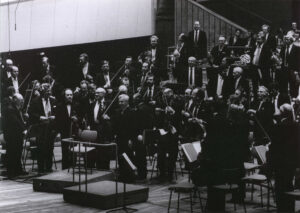04 January 2024
P.R. Jenkins
Spotlight Berg: orchestral works

“It is a tremendously difficult work. He wrote it just before the start of the Great War. To conduct it is a devastating experience: it takes up all your mind and it will take you two or three days to recover from it.”
Karajan about Berg’s ‘Three Orchestral Pieces’
It is generally accepted in the biographies about Karajan that his dedication to Mahler and the Second Viennese School was a major project in the 1970s. Even his critics consider the LP box with works of Arnold Schönberg, Anton von Webern and Alban Berg to be one of his greatest achievements as a conductor and one of the most important recording initiatives for this music. Karajan told his biographer Ernst Haeusserman: “The most complex thing was the box with the Second Viennese School. […] Of course, the record company was not very enthusiastic. They said, it won’t sell. […] I said: ‘Let’s forget about the money for a moment’ and we spent a great part of the year publishing those records. It was an immensely enriching experience […] because we practised so hard that at the end, the orchestra played it like a Beethoven symphony, they knew their way around. My own relationship to this music had changed and that was notable on these records. Good heavens, the reaction of the audience was overwhelming.”

Berg wrote his opus 6, the “Three Orchestral Pieces” in 1914 when he was not yet thirty years old. It was his first major work for orchestra and was dedicated to his teacher Schönberg. Karajan recorded it in the studio in 1972 and also performed it 24 times in concert between 1964 and 1979 – always with the Berlin Philharmonic. His biographer Peter Uehling wrote:
“With his characteristically shaped interpretation Karajan leaves no wishes open. […] Not only the sound is extreme like few things Karajan conducted […] also in the aspects of form he gives the impression of a music that is falling apart through its tensions.”
Three Pieces from the “Lyric Suite” was the other work by Berg Karajan recorded in the studio in 1973. Bernhard Uske wrote in his booklet for the DG Originals: “The luxuriant idiom of Alban Berg with its soft, rounded and gliding processes is a particularly grateful field for Karajan, of whose conducting we might say, as of Berg’s composition, that he was a master of the most minimal transitions. Berg’s ambition to savour the very finest acoustic details in his dense textures, to integrate all the ingredients to their best advantage and make them complement each other found a sympathizer in Karajan. The arrangement for large string orchestra of three movements from the Lyric Suite offers a real challenge to the conductor’s ear: how to preserve the tutti’s fullness and intense colouring without losing any of the transparency and mobility of the original scoring for string quartet.”
And Peter Uehling:
“Among the non-tonal works in the box of the Second Viennese School the Three Pieces from the ‘Lyric Suite’ deserve the highest praise because the idiom is fulfilled so perfectly and the technical problems are solved at the highest level. […] In some moments, Karajan’s interpretation makes one forget that it is an adaptation of a string quartet score. The possibilities of the string orchestra […] are exploited so fully that in comparison the original almost seems deficient.”
Concerning Karajan’s health, the “Lyric Suite” – the work of a lovesick composer – seemed to have brought him bad luck. “In January 1980, coming on stage in Berlin to conduct Berg’s ‘Lyric Suite’, he stumbled and fell. There was a loud gasp from the audience. Nor would things be any easier until after further risky spinal surgery in June 1983. As Karajan later confided, ‘Every step I have taken these last four years has been an adventure, planned and executed.’ (Richard Osborne)”

“The Berlin version of the three movements from the ‘Lyric Suite’, stressing the various contrasts but with marvelously shaded string textures, is distinctly superior to the rival […] account.”
Gramophone
The third piece Karajan would perform but not record in the studio was Berg’s beloved violin concerto. Karajan conducted it five times between 1968 and 1985 with Henryk Szeryng, Christian Ferras and Pierre Amoyal. The last occasion with Amoyal was luckily recorded for broadcasting.
Karajan never conducted Berg’s summum opus, his opera “Wozzeck”, but obviously he intended to. On the subject of the tenor Jon Vickers, he told his biographer Richard Osborne: “Later in his career, when the top of the voice started to disappear, I tried to persuade him to do ‘Wozzeck’ with me. He would have made a marvellous Wozzeck.”
By the way – after Canio, Otello and Don José it would have been the fourth(!) character in their collaboration who commits murder out of jealousy.
We’ve prepared playlists with Karajan conducting Alban Berg. Listen to them here.
— P.R. Jenkins
Richard Osborne: “Karajan. A Life in Music” Chatto & Windus, London. 1998
Peter Uehling: “Karajan. Eine Biographie” Rowohlt, Reinbek bei Hamburg. 2006
Ernst Haeusserman: “Herbert von Karajan. Eine Biographie.” Verlag Fritz Molden, Wien-München-Zürich-Innsbruck. 1978
“Conversations with Karajan” Edited with an Instroduction by Richard Osborne. Oxford University Press. 1989
Bernhard Uske: “Twelve-note classics” (Translation: Mary Whittall) in the booklet for DG The Originals STEREO 457 760-2, Deutsche Grammophon GmbH, Hamburg. 1999


